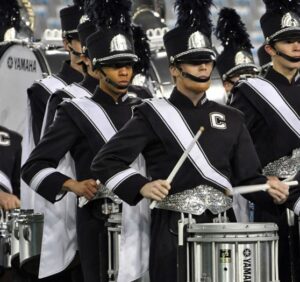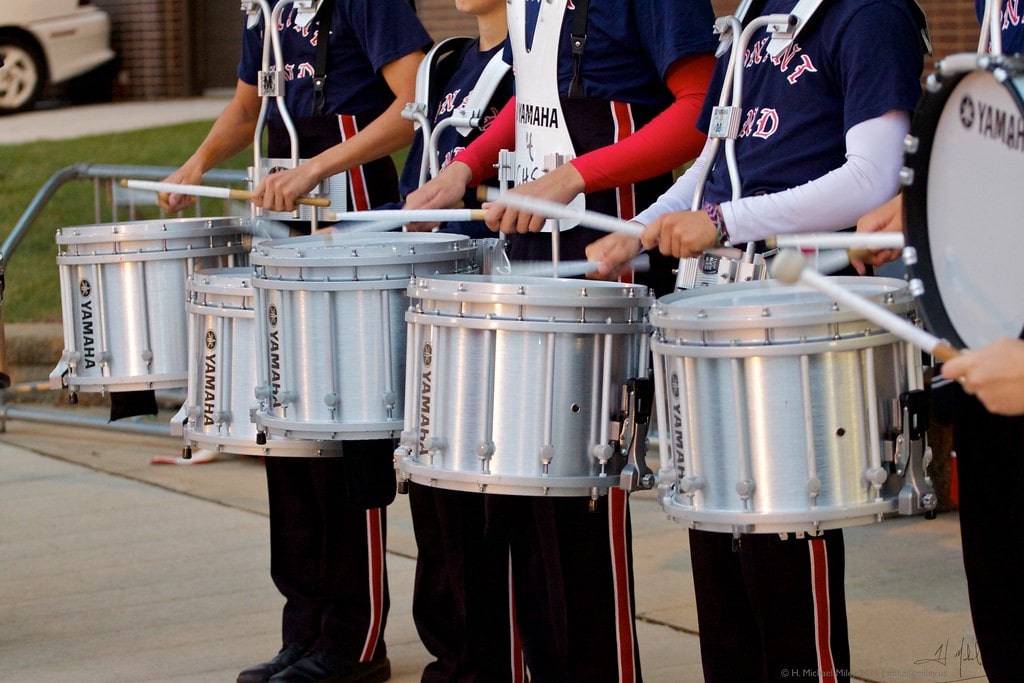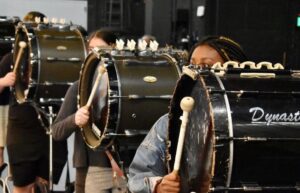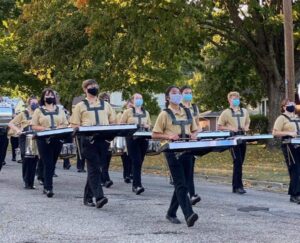Are you interested in joining your school’s marching band as a percussionist? Or are you already in your school’s drum section, and you want to start marching?
There are a few things you need to know before you make the step into the fun and exciting experience of a marching band.
Becoming a percussionist can be a time-consuming and costly endeavor, but with enough dedication and practice, you will be on your way to becoming a great drummer. The percussion section of a marching band plays a very important role and is in the top hierarchy of marching instruments.
What Does a Marching Band Percussionist Play?
A percussionist in a marching band can do more than just play drums in what is called the drumline or battery. There are multiple types of drums and other instruments that are available to the marching percussionist.
Below is a list of the common instruments you would find in the marching percussion section.
Marching Snare Drum

If you are a member of your school’s non-marching percussion section, you are probably familiar with the snare drum. This instrument has a tight mesh stretched over a cylindrical body that makes sound through metal wires that are strung underneath the mesh.
The difference between a normal snare drum and a marching snare drum is that a marching snare drum is deeper and heavier, and they usually come with a shoulder harness that you use to carry the drum while marching.
Marching Tenor Drum

The tenor drum is almost identical to a snare drum, but the tenor does not have the metal wires that a snare has. Without the wires, the tenor can make a stable sound that contrasts with the snare’s rattling.
Marching Quads and Other Configurations
A set of quads is simply four tenor drums set up in a configuration in front of the drummer. The quads also attach to a larger harness that goes over the shoulders of the drummer.
Four is not the limit, however. Sets of five and six tenors are also used, although these progressively get heavier and harder to carry.
Marching Bass Drum

The bass drum is probably one of the most recognizable instruments on the marching band field. It is a large cylindrical instrument with two heads facing either side of the drummer.
The drummer strikes the left and right sides with his or her corresponding mallet. It produces a deep, full sound. The bass drum can be one of the heavier instruments on the field, and it requires a strong, and usually large, percussionist to use it.
Bells

The bells are the first instrument on this list that are not drums. Anyone in the normal school band is familiar with the metallic sound of the bells. Bells look similar to a xylophone, except they are smaller.
The marching percussionist plays the bells upright, striking the mallets downward, or on their side, striking the mallets like the bass drum.
Cymbals

Most people are familiar with the sound of crashing cymbals. The large, circular, bronze disks come in pairs, and they are smashed together to form a resonating tone.
The percussionist typically holds the cymbals by straps that are attached to their centers.
Timpani and Larger Mallet-Based Instruments

Instruments like the xylophone and the marimba can be made into smaller versions to be marched with, but most of the time normal versions are used and kept stationary at the front of the band.
The timpani is another instrument that is typically kept upfront. It is a deep and wide drum that is too large to carry around the field.
Smaller Percussive Instruments
Depending on what pieces your marching band is playing, you may be tasked with using a handheld instrument. These include the triangle, the woodblock, and the cowbell.
Marching Sticks and Mallets
Drumsticks typically come with any percussion kit, but you might find it necessary to shop around for sticks that are thinner or thicker that better fit your hands.
Mallets come in many different forms, from soft but firm knitted ends to wooden or plastic ends. The type of mallet depends on what instrument you are playing.
How Much Do the Different Marching Band Drums Cost?
Depending on your school and your band director, you most likely will be allowed to use school equipment by paying nothing or a small fee.
However, if you are in a situation in which you must purchase your marching instruments, or if you would like to practice such instruments at home, below is a list of the typical costs for each of the main marching instruments.
These instruments’ costs will be the larger share that you will spend while playing in a marching band, but you should also consider equipment accessories and their maintenance as well.
Cost of a Marching Snare and Tenor Drum
Because of the larger sizes, the snare and tenor marching drums cost significantly more than normal drums.
- Snare drums can cost anywhere from $150 on the low end to over $200 on the high end.
- Tenors are in a slightly higher range, as a typical set of quads will cost between $320 and $400.
Cost of a Marching Bass Drum
Marching bass drums can vary in size, and varying size means varying costs. Depending on your size, a bass can cost from $400 to over $700.
Cost of Cymbals
Cymbals are cheaper than the other instruments on this list, with a good quality pair costing around $80.
You will never have to purchase your timpani, any large mallet-based instruments, or any smaller percussive tools, as these typically come from your school.
It should also be noted that these prices are a general range. A name brand can significantly drive up the price of any instrument, and a used instrument is usually much cheaper.
Skills Needed for Playing Marching Band Drums
While anyone can be successful in a marching band, percussionists in particular have to be diligent and hardworking.
Here are some skills you will need and tips that will help you be the best drummer possible, in a marching band:
You Have to be in Good Physical Shape
While it may seem that marching band only involves slow pacing around a field, marching can be physically tasking, especially for percussionists who have to carry the heaviest instruments. After a long day on the field, you will likely be exhausted and your body will be tapped out.
It is important to exercise regularly outside of marching band practice so that you can finish each event without passing out.
You Have to Have Endurance
Most marching events take place in hot weather, and you also will have to wear a thick uniform. Given these circumstances, you will probably sweat through your clothes and want to fall asleep in the middle of an event. While being physically persistent is important, being mentally persistent is more important. When you’re on the field, you have to remind yourself why you are there, especially when you feel like giving up.
You Need to Have Good Attention Skills
To keep up with the rest of the band, you have to pay close attention to the conductor. Whether this is your band director or another student, the conductor will keep you at the right tempo. Losing focus on the conductor can make your music fall behind or speed up, and this hurts the rest of the band.
You Need to Be Good at Counting
This may seem like an unneeded tip, but keeping track of your counting will allow your music to stay consistent as well as your feet. Walking too fast or too slow could throw off the people in front of you or behind you.
You Need to be Good at Multitasking
Reading sheet music, watching the conductor, playing an instrument, and marching all at the same time can certainly lead to mistakes. You have to learn how to do all of these things at once with precision and with few mistakes.
You Need to Practice
This might seem like an obvious one, but it is important to practice more than just your instrument. To get the hang of marching, you should regularly practice with your instrument on your shoulders and while walking. This will prepare you for real marching events.
You Need to Be a Team Player
Marching band is a team activity. You have to be ready to help your teammates when they make mistakes. If you notice your friend seems to have lost track of his counting, help him or her get back on track. This also means that you have to pay attention to your director and not waste time.
Getting a band together takes a lot of work, and you shouldn’t waste your valuable time.
You Should Learn How To Play the Piano
Many band directors require piano experience for anyone who wants to be a percussionist. This may seem odd, but knowing how to play the piano, even at a rudimentary level, can make it easier to read music and to understand rhythm, both of which are important for a percussionist.
Is Playing Percussion Hard?
Just as with any instrument, percussion takes a lot of practice and patience. As a percussionist, unlike the rest of the band, you are tasked with playing many instruments.
You will regularly need to practice rhythm exercises, and you will have to learn how to read music for mallet-based instruments. The percussion section often controls the tempo of the band more than the conductor due to its volume. This is why each percussionist must stay on tempo with the conductor.
Ultimately, if you practice, focus, and endure, you can become a leading percussionist in your marching band.
The Takeaway
Being a percussionist in a marching band involves a lot more than just drumming. You have a lot more to worry about as a percussionist than a trumpet or flute player. Even though it could some percussion instruments could be considered some of the easiest to start with, You will have to learn to play many different kinds of instruments.
Equipment can be expensive, but your school will likely have many instruments for you to use for little cost or you can opt to rent or even buy a used instrument.
Percussion can be tasking on the body and your mentality, but eventually, you will play it consistently while enjoying every minute of it.
What Drums Are in a Marching Band?
The percussion section of a marching band is normally made up of snares, tenors, and bass drums.
How Much Does Each Drum Weigh?
Snares: 10-18 pounds
Tenors (Quads): 12-26 pounds
Bass: 13-26 pounds
What is the Loudest Instrument in the Percussion Section?
Typically the snare drum is the loudest, but the bass drum carries a heavy tone that can reverberate throughout the field.
What’s the Hardest Part About Marching Band Drumming?
Carrying heavy equipment is very tiring, and it can leave you exhausted at the end of an event.
Why do I Need to Know Piano to Play the Drums?
Learning piano teaches basic rhythm techniques that are invaluable to the drummer.
How Different is Marching Band Percussion from Regular Band?
Depending on what level, but the marching band percussion section can be considered much harder than the section on a regular band, as it takes a lot more work, practice, dedication, and is physically and mentally more.
Will I Have to Learn to Read Music?
Yes. You will learn what rhythms correspond to which notes. You will also need to know how to read notes off the treble and bass scales, the two foundational scales of music.

